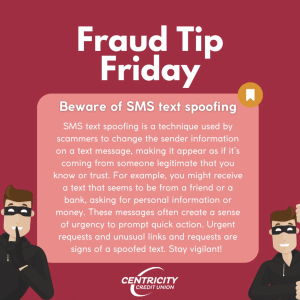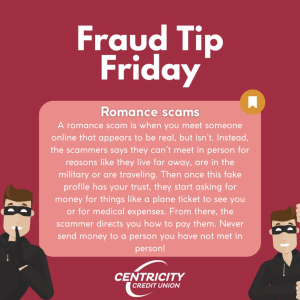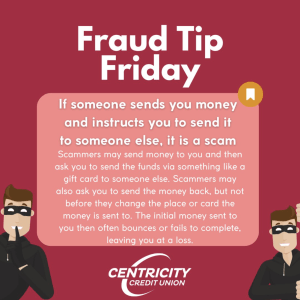Fraud Resources

Call our Contact Center if you suspect fraud
Contact Center Hours
Monday - Friday
8:00 am – 5:30 pm

Learn How to Protect Yourself from Fraud
Visit the FTC website for the latest in advice, fraud trends, and how to protect yourself.

Monitor for Identity Theft
Access your free credit report to protect yourself against fraud.

Set up alerts in your Online Banking to protect your accounts
Get alerts on your phone
Get alerts on your phone when your balance drops below a specified amount, when a check clears, or when a deposit is made.
- Login to Online Banking
- Select “Settings”
- Select “Security & Alerts”
- Select “Alerts”
Customize your alert preferences to stay up to date on your account activity!
Enroll in Text Fraud Monitoring
Keep your Centricity Credit Union cards safe with a text
Our text alert service allows you to instantly keep tabs on suspicious card activity. With text fraud alerts, if our system detects suspicious activity on your card, you’ll receive a text message with details about the suspected transaction. All you have to do is respond to the text to confirm the transaction. If you indicate the transaction is fraud, you’ll receive another message with a number to call for follow-up. If not, you’re all set. The system will mark the transaction as legitimate and you can get on with your day – simple as that.
Click HERE to enroll in Text Fraud Monitoring.



Open Account
Access Online Banking
NMLS#
| CentricityCU | NMLS# 712334 |
| Feather Tankersley | NMLS# 1016179 |
| Linda Proctor | NMLS# 343288 |
| Billye Coenen | NMLS# 758779 |
Leaving Our Website
You are leaving our website and linking to an alternative website not operated by us. We do not endorse or guarantee the products, information, or recommendations provided by third-party vendors or third-party linked sites.